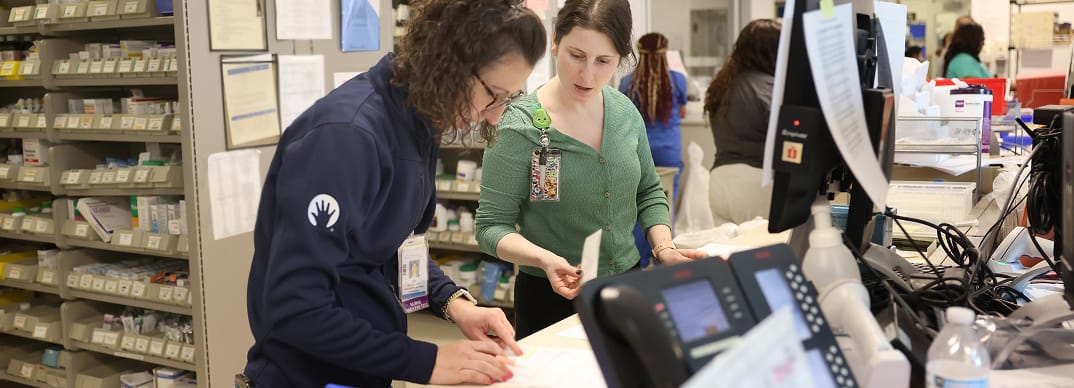Interprofessional Practice
Nurses Innovate During Downtime to Provide Exceptional Care
Lurie Children’s nurses are integral leaders of the interprofessional teams that guide the organization through its most challenging times. For several weeks in early 2024, Lurie Children’s successfully navigated through a downtime of the electronic medical record system and other electronic systems. Many electronic workflows had to be managed through a paper process. During this time, nurses leaned on their adaptability and expertise to not only maintain standard operating procedures within nursing teams, but to lead the way in improving interprofessional clinical workflows.

Lisa Hawks, MSN, APRN, CRNA and Leah Parks, DNP, APRN, CRNA
Jenifer Horn, MSN, APRN, FNP-C, Director of Heart Center Advanced Practice & Nursing, collaborated with Pathology and Laboratory Services team and ordering providers to optimize laboratory procedures. Horn used quality improvement methodology to improve the efficiency of the STAT lab ordering by clarifying and communicating the criteria for STAT labs. Horn also assisted in the improvement of other laboratory workflows, such as the requisition and handoff processes leading to increased efficiency in these workflows.
Brian Stahulak, DNP, MBA, RN, NEA-BC, Chief Nursing Officer & Chief Clinical Officer, led the organization by developing multiple innovative solutions, including enhanced Pharmacy downtime procedures. Amanda Labadie, MSN, APRN, CPNP-PC, Director of Interventional Cardiology, operationalized this innovation, leading to additional safety mechanisms in the medication ordering and administration process. Through this process, clinical teams had access to printed medication administration records (MAR), printed medication labels, and utilization of the pediatric drug formulary features. The printed MARs also saved clinical nurses a significant amount of time by eliminating the need for the daily manual transcription of the MAR.
“Nurses across the organization provided the inspiration needed to lead through the many changes that occurred with an extended downtime,” said Stahulak. “Their unique understanding of the clinical picture led to creative problem-solving and strong collaboration with multiple teams so that patients continued to receive exceptional care.”
Impactful Interventions to Improve Physician and Nurse Communication
For the last three years, Huong Mai, BSN, RN, CPN, Erin Burke, MSN, RN, CPN, CNL, and an extensive team of interprofessional experts from across the hospital have been working diligently to improve communication between nurses (RN) and physicians (MD) on Inpatient 21, General Medicine/Pulmonary, at Lurie Children’s. Their insights, interventions and outcomes have made such an impact for their clinical teams that the strategy is in the process of being implemented on other acute care units at Lurie Children’s. But setting out to accomplish something that required a change in professional habits was no small feat.
In 2022, emerging from a work environment adapted to respond to the COVID-19 pandemic revealed new communication challenges between nurses and physicians on Inpatient 21. Face-to-face interactions and rounds were fewer, and text message correspondence on the new Voalte smartphones was less concise. These distanced ways of working weren’t prompting the same efficient, productive RN/MD communication of the past. A group of clinical nurses on Inpatient 21 recognized that these barriers to communication were reducing teamwork, causing delays in care and impacting both patient and staff satisfaction.
“I’m passionate about improving care. I wondered how we could do our jobs better and make them easier. If we communicate well, both are possible, I knew this could work.”
Huong Mai, BSN, RN, CPN, General Med/Pulmonary
With additional support from the Center for Quality and Safety, Inpatient 21 Clinical Quality Coordinator, Inpatient 21 Medical Director, and hospital-based medicine attendings, the team worked to implement several tactics. These included revisions to rounding participation and a rounding checklist, standardized communication for Voalte correspondence, building in more opportunities for in-person or phone call communication, and integration into the electronic medical record system with support from the Nursing Informatics team. Education around these tactics was integrated and sustained through RN and MD staff meetings, e-mails, digital signage and top-down conversations, and reinforced often in person by project leaders like Mai.
After some trial and error and continued strategy to find the most seamless yet effective guidelines, the team began to see the participation, improved teamwork and efficiency they set out to achieve.

Erin Burke, MSN, RN, CPN, CNL, Nursing & Clinical Excellence, Martin Duncan, MD, and Huong Mai, BSN, RN, CPN, General Med/Pulmonary
“It came down to a lot of education, reinforcement of that education and recognizing compliance,” says Mai. “Our goal was to teach our teams to communicate efficiently to elicit the response they need.”
A staff survey conducted for six months post implementation revealed encouraging data: RNs’ perceptions of teamwork increased by 27 percent and medical resident perceptions increased by 13 percent. Additionally, attitudes over the risks of miscommunication became more aligned. Furthermore, a remarkable 166 percent increase in patient family experience (PFE) scores regarding communication between RNs and MDs was experienced six months post interventions. To date, average PFE scores have remained higher than pre-intervention. The success of the project warranted a larger, hospital-wide rollout of the proven communication tactics to other acute care floors, which is currently in progress. Mai and Burke have presented this work both across Lurie Children’s and at various nursing conferences.
